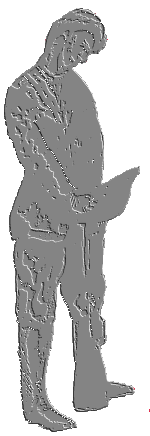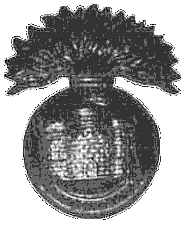 |
THE IRISH IN UNIFORM
THE ROYAL INNISKILLING FUSILIERS |
 |
1 st. Battalion, Royal Inniskilling Fusiliers landing on the beaches at Gallipoli, 25 th. April 1915. |
| This regiment was originally
raised in 1689 as a Regiment of Foot to defend the Irish
town of Inniskilling, the only town in the British Isles
to raise and name two regiments for its own defence, The
Royal Innikilling Fusiliers and The 6th. Inniskilling
Dragoons. Between 1756 and 1796 the regiment of fusiliers
saw service in Canada, America, Havana (Cuba), St. Lucia
and Martinique (West Indies). In The West Indies, the
losses to the regiment were considerable, and mainly due
to yellow fever rather than death in combat. The regiment
was called upon to serve the British Crown in The West
Indies again, fighting against the French forces in St.
Lucia, where (on 24 May 1796) they heroically stormed the
French fortress of Morne Fortune. This action resulted in
the name 'St. Lucia' being added to the regiment's Battle
Honours, and has been commemorated ever since by The
Inniskilling Fusiliers on that date as St. Lucia Day. In 1800, volunteers from the Donegal and Fermanagh Militias were formed into a 2nd. Battalion of The Royal Inniskillings (known informally as "The 'Skins"), and saw service in Malta and Egypt. The Regiment took part in the seige of Alexandria in Egypt in 1801. After The Egyptian Campaign, the 2nd. Battalion was disbanded, and then formed again in 1804 from the men from the Ulster Counties of Down, Fermanagh and Armagh. A 3rd. Battalion was raised in 1805. From that year until 1814, these Irishmen were fighting in Sicily and Spain as part of the forces led by Lord Wellington. In 1815, during the Napoleonic War, they fought at The Battle of Waterloo in Belgium. The 1st. and 3rd. Battalions also saw service in Canada. Later in the Nineteenth Century, the regiment took part in the campaigns of The Kaffir War and The Boer War in South Africa, and also served in India, Gibraltar, Burma, and Hong Kong. In the early years of the Twentieth Century, the regiment served in Egypt, South Africa, India, Crete and China. The Nineteenth Century Battle Honours of The Royal Inniskilling Fusiliers, carried on The Regimental Colour are: 'Martinique 1762', 'Havannah', 'St. Lucia 1778, 1796', 'Maida', 'Badajoz', 'Salamanca', 'Vittoria', 'Pyreneees', 'Nivelle', 'Orthes', 'Toulouse', 'Peninsula', 'Waterloo', 'South Africa 1835, 1846-1847', 'Central India', 'Relief of Ladysmith', 'South Africa 1899-1902'. In addition to the two regular battalions of the regiment and its 3rd. and 4th. reserve battalions, eight extra service battalions were raised (mostly in 1914) to fight in World War I against the threat of tyranny in Europe. The 5th. and 6th. Battalions went into action with the 10th. (Irish) Division in the Gallipoli landings in Turkey in August 1915. They then saw service in The Middle East, and then went to France in the Autumn of 1918 to take part in the final Allied advances before "The Great War" ended on 11 November. The 9th., 10th. and 11th. Battalions fought with the 36th. (Ulster) Division on the first day of The Battle of the Somme on 1st. July 1916. Their task was to capture the third line trenches across the River Ancre. An artillery bombardment failed to destroy the German defences, and the Allied forces sustained heavy losses in their attack. Only The Royal Inniskilling Fusiliers and the Southern Irishmen of The Royal Irish Rifles reached and held their objectives on that fateful first day in July, and were then obliged to withdraw due to lack of support (caused by the very heavy losses of other units). This joint action by the Inniskilling men from Ulster and men from the 3 Provinces of Ireland which were later to become The Irish Republic, was remarkable in that their political and religious differences were set aside as the two regiments fought alongside each other against the enemy forces of The Central Powers in the cause of freedom in Europe. They saw at first hand and acknowledged the heroic acts of men from all over the island of Ireland, fighting as comrades in a common cause. The 7th. and 8th. Battalions of The Inniskilling Fusiliers took part in the latter stages of The Battle of the Somme, when they attacked and captured the heavily defended vilages of Guillemont and Ginchy in September 1916. At the outbreak of The Great War, the 2nd. Battalion was stationed in barracks at Dover, on England's South Coast, and landed at Le Havre in France with the British Expeditionary Force (B. E. F.) in August 1914. These troops took part in The Battle of Le Cateau and there protected the left flank of the British Army as it fell back to the River Marne after attempting to stem the German advance. This battalion remained fighting in France for the four years of that war. By 1917, the losses sustained by the British Army were so considerable that the battalions of The Royal Inniskilling Fusiliers from the 36th.(Ulster) Division were actually combined with the troops of the 16th. (Irish) Division. At The Battle of Messines Ridge, Irishmen from both North and South fought alongside each other, with old rivalries between Catholic and Protestant, Nationalist and Republican being forgotten in the struggle to stay alive and achieve their military objectives. This battle was the most succesful undertaken by British forces during The Great War, with the ridge being captured with few casualities and all objectives taken. In August 1917, these Irishmen took part in another joint action at the Third Battle of Ypres, where their combined forces inThe Ulster Division lost a third of their men to enemy artillery bombardment even before the attack began. At the end of 1917, Irish troops took part in the Battle of Cambrai, when attempts were made to breach the miles of vicious barbed-wire entaglements which formed part of the defences of The Hindenburg Line. The fighting of 1917 caused so many losses that the 10th. and 11th. Battalions of The Royal Inniskilling Fusiliers were disbanded, and the 7th. and 8th. Battalions were amalgamated. These remnants of the regiment bore the brunt of the Spring Offensive in March 1918, when the German Army made a last desperate attempt to gain victory. During this offensive, many battalions of The Allied Forces on certain sections of The Western Front were almost annihilated. In the fierce fighting, the 1st. Battalion of The Royal Inniskillings lost 500 men from a total strength of 670 - a loss of almost 75%. The 1st. Battalion was in India in 1914 when war broke out in Europe, and in 1915 they sailed to England and joined the 29th Division, Expeditionary Force (Mediterranean), before sailing with that force to land in Gallipoli, Turkey. This landing saw heroic fighting on the part of the Expeditionary Force, but the campaign saw heavy losses both from the fierce fighting and from disease. The landing at Gallipoli on 25 April 1915 by the brave Irishmen of The Royal Inniskilling Fusiliers was commemorated by a painting by war artist L. A. Wilcox, shown at the top of this page. The bravery of the Inniskillings was exceptional during World War I, and it was a said of them that "their very valour was their destruction". They had the sad distinction of having suffered the highest casualties of any British regiment during one day of action in war. On 1 July 1916 during the Battle of The Somme, 2208 men of The Inniskillings were killed in action. Between 1914 and 1918, no less than 7 men of The Royal Inniskilling Fusiliers were awarded the highest award for bravery, The Victoria Cross: Captain G.R. O' Sullivan 1 July 1915 Krithia, Dardanelles, Killed in action. Sergeant James Somers 1 & 2 July 1915 Gallipoli, Turkey. Captain E. N. F. Bell of 9th. Battalion 1 July 1916 Thiepval, France. Second Lieutenant J. S. Emerson of 9th. Battalion 6 December 1917. Killed in action. Private J. Duffy (Stretcher Bearer) L. G. 27 February 1918 Lance Corporal E. Seaman of 2nd.Battalion, L. G. 15 November 1918 Ypres Sector, France Private N. Harvey 20 October 1918 Ingoyghen The Battle Honours of The Royal Inniskilling Fusiliers regarding the First and Second 'World Wars' displayed on The Queen's Colour are: 'Le Cateau', 'The Somme 1916 & 1918', 'Ypres 1917 & 1918', 'St. Quentin', 'Hindenburg Line', 'France and Flanders 1914 -1918', 'Macedonia 1915 - 1917', 'Landing at Helles', 'Gallipoli 1915 - 1916', 'Palestine 1917 - 1918', 'North West Europe 1940', 'Djebel Tanngoucha', 'North Africa 1942 - 1943', 'Centuripe', 'Sicily 1943', 'Garigliano Crossing', 'Cassino 11', 'Italy 1943 - 1945', 'Yenangaung 1942', 'Burma 1942 - 1943'. For more details on the history of The Royal Inniskilling Fusiliers contact or visit The Royal Inniskilling Fusiliers Regimental Museum, The Castle, Enniskillen, County Fermanagh, Northern Ireland, BT74 7BB, Telephone # 01365-323142. |
| Use this button to go to the Navigation Buttons at the top of this page. | |
This
site webcrafted for The Fame of Tipperary Group,
Tipperary Town, County Tipperary, Ireland by the WebWizards© at The
Plug-in Office ®,, e-mail to plugin@iol.ie All text, backgrounds, graphics, images Copyright © 2000 WebWizards or as acknowledged. |
|